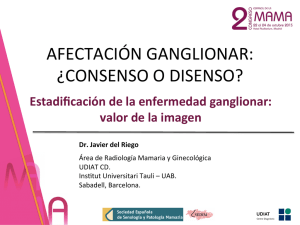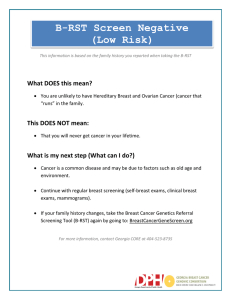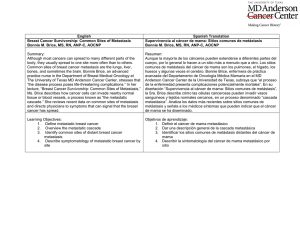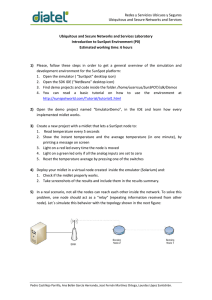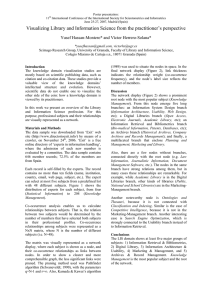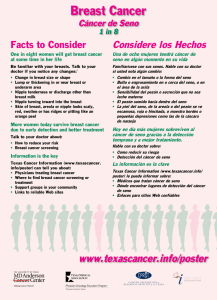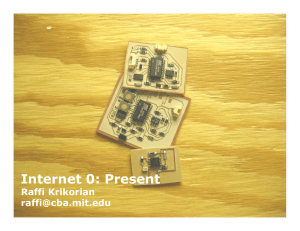TAULA RODONA: QUE FEM AMB ELS GANGLIS?
Anuncio
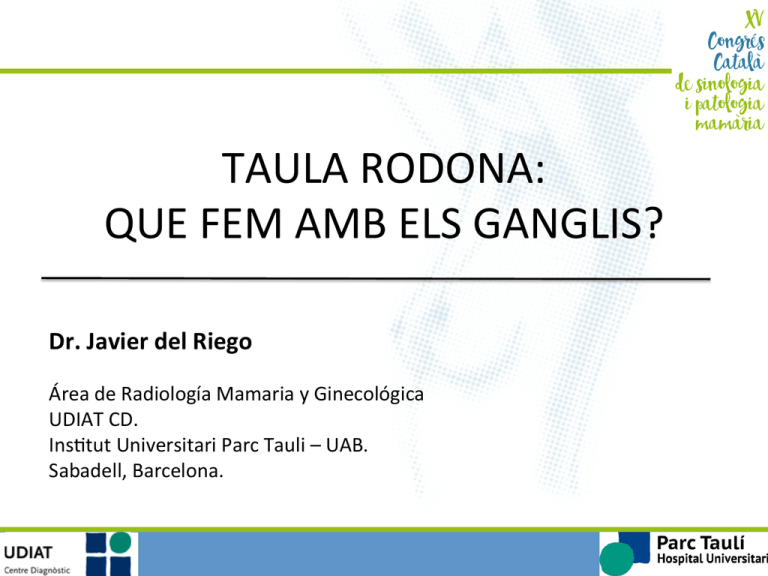
TAULA RODONA: QUE FEM AMB ELS GANGLIS? Dr. Javier del Riego Área de Radiología Mamaria y Ginecológica UDIAT CD. InsFtut Universitari Parc Tauli – UAB. Sabadell, Barcelona. Manejo axilar BI-­‐RADS 6 EcograNa Axilar STOP INESPECÍFICO SOSPECHOSO BSGC PAAF LINFADENECTOMIA Manejo axilar BI-­‐RADS 6 EcograNa Axilar STOP INESPECÍFICO SOSPECHOSO BSGC PAAF LINFADENECTOMIA Manejo axilar BI-­‐RADS 6 EcograNa Axilar INESPECÍFICO STOP SOSPECHOSO BSGC PAAF LINFADENECTOMIA ¡¡Evitar un 2do Bempo quirúrgico!! Manejo axilar ¿Hay cáncer en la axila? NO SI BSGC LINFADENECTOMIA Manejo axilar TRIAL ACOSOG Z0011 Febrero 2011 Giuliano AE, Hunt KK, Ballman K V, Beitsch PD, Whitworth PW, Blumencranz PW, et al. Axillary dissecFon vs no axillary dissecFon in women with invasive breast cancer and senFnel node metastasis: a randomized clinical trial. JAMA 2011;305:569–75. TRIAL ACOSOG Z0011 TRIAL ACOSOG Z0011 BSGC NO LINFADENECTOMIA v cT1 – T2; N0 v BSGC ≤ 2 macrometástasis v Tratamiento conservador v Radioterapia v Tratamiento adyuvante sistémico (97%) TRIAL ACOSOG Z0011 TRIAL ACOSOG Z0011 TRIAL ACOSOG Z0011 – LIMITACIONES • No concluyó en reclutamiento (891 de 1900 previstas). • Baja representación de la muestra (bajo reclutamiento en 50% de centros). • Baja esFmación de supervivencia para grupo control (75% a 5 años). • Tumores pequeños • Pacientes grandes (> 50 años) • 80% Rc Estrogenicos + (tumores de buen comportamiento biológico) • No información del Her2 y Ki67 • Alto % de micrometástasis (LA: 48.8%; BGSC: 37,5%) Sesgo de inclusión! • Casos avanzados en Grupo de LA (mayor tamaño, mayor invasion A-­‐L, mayor ganglio afectos). Sesgo de aleatorizacion. • No describe la Radioterapia • Pérdida del seguimiento del 19,4%. • Escaso Fempo de seguimiento (6.3 años). TRIAL ACOSOG Z0011 TRIAL ACOSOG Z0011 -­‐ IMPACTO Printed by Javier Horacio del Riego Ferrari on 6/14/2016 10:35:47 AM. For personal use only. Not approved for distribution. Copyright © 2016 National Comprehensive Cancer Network, Inc., All Rights Reserved. #++#.*O<6@7<5@D.$@JD<B5.IUI;9V. "5E4D<E@.!J@4D>.+45=@J !""!#$%&'()&*(+#,*'(./(0+1#"0*2(/#304)(#56#"5*1(*1+ 7&+2%++&5* '()*"+,-.,/"--,)0.'1,*"#*.%.'1,*2."3."",3.""!.456.777,.183.#93.:; +7<5<=477A.5B6@. CBD<><[email protected]>.><F@. BG.6<4?5BD<D9 ,H<774JA.6<DD@=><B5.7@E@7."K"" '@@.,H<774JA.-AFCL.#B6@.'>4?<5?.M!"#$%2N W#,.BJ.=BJ@. T<BCDA.CBD<><E@ W#,.BJ.=BJ@. T<BCDA.5@?4><E@ +7<5<=47. '>4?@."3."",3. ""!.456.777,. 183.#93.:; '@5><[email protected]@. 5@?4><E@8 #B.GOJ>[email protected]<[email protected]=4>@?BJA.9N #B.GOJ>[email protected]<774JA. DOJ?@JA. +7<5<=477A.5B6@. 5@?4><[email protected]>.><F@. BG.6<4?5BD<D '@5><[email protected]@. F4CC<5?.456. @H=<D<B5I38 '@5><[email protected]@. CBD<><E@8 '@5><[email protected]@. QRWLGHQWL¿HG :@@>D.,--.BG.>[email protected]<5?.=J<>@J<4Q R.19.BJ.1I.>OFBJ R.9.BJ.I.CBD<><[email protected]@5><[email protected]@D R.!J@4D>%=B5D@JE<5?.>L@J4CA R.SLB7@%TJ@4D>.)1.C7455@6 R.#B.CJ@BC@J4><E@.=L@FB>L@J4CA 0@D.>B.477 #B ,H<774JA.6<DD@=><B5. 7@E@7."K"" '@@.,H<774JA.-AFCL. #B6@. '>4?<5?.M!"#$%2N 8&RQVLGHUSDWKRORJLFFRQILUPDWLRQRIPDOLJQDQF\LQFOLQLFDOO\SRVLWLYHQRGHVXVLQJXOWUDVRXQGJXLGHG)1$RUFRUHELRSV\LQGHWHUPLQLQJLIDSDWLHQWQHHGVD[LOODU\O\PSK elephone system when frozen section or touch preparation analysis documented a tumor-involved SN. Although some of these patients were subsequently found to have 3 or more tumor-involved SNs, they were included in the analyses. All patients gave written informed onsent, and all institutions obtained approval by their institutional eview board. There were 165 investigators and 177 institutions particpating in this study. Figure 1 illustrates the study schema. variables between groups. Cox proportional hazards models were used to assess the univariable and multivariable association between prognostic variables, treatment, and locoregional recurrence. All statistical tests were 2-sided and a P value of 0.05 or less was considered statistically significant. Analyses were performed with SAS statistical analysis software, version 9.1 (SAS Institute, Cary, NC). TRIAL ACOSOG Z0011 RESULTS Enrollment to Z0011 began in May 1999 with a planned accrual of 1900 patients. The trial was closed in December 2004 due to lower than expected accrual and event rates. There were 891 patients randomized with 35 patients (25 on the ALND arm and 10 on the SLND alone arm) excluded because they withdrew consent from the study. Eligible patients underwent lumpectomy and SLND alone or lumpectomy with SLND and completion ALND. Statistical analyses were performed on an intent-to-treat basis with 420 patients in the SLND " ALND arm and 436 in the SLND only arm. There were 43 (5.0%) patients who did not undergo their assigned treatment. Of the 420 patients assigned to the ALND arm, 32 (7.6%) did not undergo ALND and, of the patients who were assigned to the SLND alone arm, 11 (2.5%) had ALND. Figure 2 shows the trial participants by study arm (the intent-to-treat sample) and the number of patients who received ALND (388 patients) and SLND alone (425 patients) as originally assigned (the treatment received sample). The primary analyses were performed on the intent-to-treat sample, and all were repeated for the treatment received sample. Both analyses yielded similar results with no significant change in outcomes. Within the intent-to-treat sample, there were 103 ineligible patients: 47 on the ALND arm and 56 on the SLND only arm. Reasons for ineligibility were incorrect number of positive SNs (16 ALND arm and 32 SLND only arm), SNs positive by IHC only (4 ALND arm and 4 SLND only arm), positive lumpectomy margins (6 ALND arm and 7 SLND only arm), gross extracapsular extension in the SNs (8 ALND arm and 7 SLND only arm), and other (13 ALND arm and 6 SLND only arm). In both the intent-to-treat and treatment received samples, the 2 treatment arms were well balanced in terms of baseline patient and tumor characteristics (Table 1). The number of lymph nodes removed and the extent of metastatic involvement for each study arm is presented in Table 2 with interquartile range (IQR), which reports the 25th and 75th percentile range. the patients randomized to the ALND arm,lymph the median FIGURE 1.AStudy design showing randomization process. P, Leitch Giuliano E, McCall L, Beitsch P, Whitworth PW, Blumencranz a M, eFor t al. Locoregional recurrence auer senFnel node total dissecFon with or without axillary dissecFon in paFents with senFnel lymph node metastases: the American College of Surgeons Oncology Group Z0011 randomized trial. Ann Surg 2010;252:426–32. © 2010 Lippincott Williams & Wilkins www.annalsofsurgery.com | 427 v BSGC A TODOS!! v NO ECO/PAAF!! TRIAL ACOSOG Z0011 ¿Hay cáncer en la axila? NO SI BSGC LINFADENECTOMIA TRIAL ACOSOG Z0011 ¿Hay cáncer en la axila? NO SI BSGC LINFADENECTOMIA TRIAL ACOSOG Z0011 ¿CUANTO cáncer hay en la axila? ≤ 2 OBSERVACIÓN > 2 LINFADENECTOMIA Manejo axilar BI-­‐RADS 6 EcograNa Axilar/PAFF NO ACOSOG Z11 ¿Hay cáncer en la axila? ACOSOG Z11 ¿Cuánto cáncer hay en la axila? Valor actual de la EcograNa/PAAF Axilar ¿EcograNa axilar? Valor actual de la EcograNa/PAAF Axilar Baja carga axilar vs Alta carga axila ECOGRAFIA/PAAF Alto Valor PredicFvo NegaFvo Alto Valor PredicFvo PosiFvo BAJA Carga Axilar (LN+ ≤ 2) ALTA Carga Axilar (LN+ > 2) Control por BSGC LINFADENECTOMÍA Valor actual de la EcograNa/PAAF Axilar Author's personal copy Eur Radiol DOI 10.1007/s00330-015-3901-2 ABRIL 2016 BREAST The impact of preoperative axillary ultrasonography in T1 breast tumours Javier del Riego 1 & María Jesús Diaz-Ruiz 2 & Milagros Teixidó 3 & Judit Ribé 4 & 6 Mariona Vilagran 1,5 & Lydia Canales & Melcior Sentís 7 & copy Author's personal Grup de Mama Vallès-Osona-Bages (GMVOB; Cooperative Breast Workgroup Vallés-Osona-Bagés) Eur Radiol Received: 26 February 2015 / Revised: 8 June 2015 / Accepted: 23 June 2015 # European Society of Radiology 2015 sensitivity: 52.6 % (pNmic positive)/72.0 % (pNmic negaAbstract Objectives To (a) determine the diagnostic validity of axillary tive). In the simulation environment, AUS had 75.0 % sensiultrasound (AUS) in pT1 tumours and whether fine-needle tivity, 88.9 % specificity and 99.2 % NPV. Conclusion AUS has moderate sensitivity in T1 tumours. As aspiration (FNA) improves its diagnostic performance, and ALND is unnecessary in micrometastases, considering (b) determine the negative predictive value (NPV) of AUS micrometastases ‘N negative’ increases the practical impact in a simulation environment (cutoff: two lymph nodes with of AUS. macrometastases) in patients fulfilling American College of In patients fulfilling ACOSOG Z0011 criteria, AUS alone Surgeons Oncology Group (ACOSOG) Z0011 criteria. Materials and methods This retrospective multicentre crosscan predict cases unlikely to benefit from ALND. Key Points sectional study analysed diagnostic accuracy in 355 pT1 • AUS+FNA can predict axillary involvement, thus avoiding breast cancers. All patients underwent AUS; visible nodes SNB. underwent FNA regardless of their AUS appearance. Sentinel • Not all patients with axillary involvement need ALND. node biopsy and axillary lymph node dissection (ALND) were • Axillary tumour load determines axillary management. gold standards. Data were analysed considering • AUS could classify patients according to axillary load. micrometastases ‘positive’ and considering micrometastases ‘N negative’. The simulation environment included all patients fulfilling ACOSOG Z0011 criteria. Fig. 1 Flow Axillary diagram for the entire series. NVLN 22.8 nonvisible node;sensitivity: NGS non-gold-standard; NCT neoadjuvant chemotherapy Results involvement: %;lymph AUS Keywords Breast cancer . Axillary ultrasound . Percutaneous 46.9 % (Nmic positive)/66.7 % (Nmic negative); AUS+FNA biopsy . Sentinel lymph node biopsy . Axillary surgery MULTICENTRICO. RETROSPECTIVO § N: 355 (pT1) § N+: 81/255 (22.8%) § AUS: S: 66.7%; E: 91.1% VPN: 94.2% § N= 288 pT1 (ACOSOG) § VPN (Cutoff > 2 LN+): 99.2% § Del Riego J, Diaz-­‐Ruiz MJ, Teixidó M, Ribé J, Vilagran M, Canales L, et al. The impact of preoperaFve axillary ultrasonography in T1 breast tumours. Eur Radiol 2015 Jul 12. transducers with various US scanners. US studies examined The flowchart in Fig. 1 shows the tumours and data includElectronic supplementary The online axilla ipsilateral to the tumour craniocaudally, reviewing ed in the first substudy. The material analyses included 355version pT1 tu-of thisthearticle (doi:10.1007/s00330-015-3901-2) contains supplementary Berg levels I, II and III [39]. mours studied by AUS (in 349 patients; six patients had syn- material, which is available to authorized We classified lymph nodes according to their morphologichronous bilateral pT1 tumours). users. In 55/355 (15.5 %), FNA cal criteria and we defined: was not done: 43 because AUS detected no nodes and 12 4 because patient and/or technical factors precluded FNA. Fi- Valor actual de la EcograNa/PAAF Axilar Ann Surg Oncol DOI 10.1245/s10434-014-3674-x ORIGINAL ARTICLE – BREAST ONCOLOGY Axillary Ultrasonography in Breast Cancer Patients Helps in Identifying Patients Preoperatively with Limited Disease of the Axilla § A. M. Moorman, MD1, R. L. J. H. Bourez, MD2, H. J. Heijmans, MD1, and E. A. Kouwenhoven, MD, PhD1 Ultrasonography forGroup Limited Disease of Netherlands; the Axilla2Departments of Radiology, Hospital Group Departments of Surgery, Hospital Twente, Almelo, The Twente, Almelo, The Netherlands 1 § RETROSPECTIVO. UNICÉNTRICO N= 851 (c T1 – T2 cN0) EcograNa negaFva § SepFembre ALND in case of a positive SLN, in which case the treatTABLE 3 Subdivision by clinical and pathologic tumor status Conclusions. The risk of more than 2 positive axillary ABSTRACT ment nodes is relatively breaststrategy includes whole-breast radiation alone or Background. The sentinel lymph node biopsy (SLNB) Clinical T status Pathologic T statussmall in patients with cT1–2 2014 cancer. US of the axilla helps in further identifying patients procedure is the method of choice for the identification and combined with adjuvant therapy after lumpectomy of T1–2 with a minimal risk of additional axillary disease, putting monitoring of regional lymph node metastases in patients cT1, n cT2, n pT1, n pT2, n pT3, n cT1: PN (>2LN+): ALND up for discussion. with breast cancer. In the case of a positive sentinel lymph breast cancer. They§ found no V significant benefit 9 in9% loco(%) (%) (%) node (SLN), additional (%) lymph node (%) dissection is still regional control or§ overall survival with completion pT1: V PN (>2LN+): 99.1% warranted for regional control, although 40–65 % have no 35 Sentinel lymph node biopsy (SLNB) has revolutionized additional axillary disease. Recent studies show that after B2 617 (99) 212 (93.0) 568 (99.1) 247 (95.0) 14 (77.8) ALND. the management of clinically node-negative women with breast-conserving surgery, SLNB, and adjuvant systemic Positive breast cancer. It is a safe and accurate method for axillary Other recent studies have also questioned the additional therapy, there is no significant difference between recurstaging, and it causes substantially less postoperative rence-free lymph period and overall survival if there are B2 § cT2: PN metastases (<2LN+): and, 93% value of ALND in patients withVSLN more positive axillary nodesnodes. The purpose of this study was morbidity than axillary lymph node dissection (ALND). The recommended management for patients with sentinel preoperative identification of patients with limited axillary importantly, proposed a routine ALND after positive SLN. § pT2: VPN (<2LN+): 95% (SLN) metastases4 is(22.2) still ALND in cases of 6 by (1.0) 16 (7.0) 5 lymph (0.9) node 13 (5.0) disease[2 (B2 macrometastases) using ultrasonography. SLN metastases larger than 0.2 mm. However,First, the need ALND is associated with considerable morbidity Methods. Positive Data from 1,103 consecutive primary breast for ALND has recently been questioned because the cancer patients with tumors smaller than 50 mm, no pal4,24,41,42 when Second, several lymph and a maximum of 2 SLNs with SLN has shown to be the only positive lymph node in 40–compared with SLNB alone. pable adenopathy, For these patients, ALND nodeswere collected. The variable of interest 65 % of these patients. macrometastases retrospective studies have been published reporting low offers no additional diagnostic, prognostic, or therapeutic was US of the axilla. axillary benefit while subjecting risk of recurrence rates in patients with positive SNs who Results. the 1,103 included, remained T Of tumor, cT patients clinical tumor1,060 size, pT pathologic tumor size them to a significant additional morbidity. The incidence of nodal metastases is after exclusion criteria. Of these, 102 (9.6 %) had more didmamnot have ALND. The axillary recurrence rate was less lower since the introduction of routine screening than 2 positive axillary nodes on ALND. Selected by Moorman M, the Bourez RofLJH, Hnodes, eijmans HJ, Kouwenhoven . Axillary Ultrasonography in Breast ancer PaFents in IdenFfying PaFents Pthe reoperaFvely mography. E aThe widespread use of chemotherapy, unsuspected US, chance having [2 positive lymph of aaxillary lymph being moderately sensitive (48.8– than 2 %.C8,11–14,16,17 InHelps a review by Rutgers, 2- to 3-with Limited Disease radiation therapy, and endocrine therapy may also dimin%). S This is signifof nodes the A(LNs) xilla. isAsubstantially nn Surg Olower ncol (4.2 2014. ep;21(9):2904-­‐10. 87.1 %) and specific depending of theIn addition, year the risk of axillary recurrence was even lower: 0–1.4 % in ish the%), added benefit of ALND. icant on univariate and fairly multivariate analysis.(55.6–97.3 After AMAROS trial showed that the absence of knowledge of excluding the patients with extracapsular extension of the reference standard. With the use of US-guided biopsy, the untreated axilla.43 Because the recurrence rates in these axillary status did not modify postoperative the treatment SLN, the chance of having [2 positive LNs is only 2.6 %. 38–40 planning. For pT1–2, this is 2.2 %.increases to 100 %. specificity studies were similar between groups, this also suggests that A number of reports have suggested that in selected By implementing routine US of the axilla in the selec1–5 6 7–17,25 10,18–23 24 12 25 Valor actual de la EcograNa/PAAF Axilar Ann Surg Oncol DOI 10.1245/s10434-015-4717-7 ORIGINAL ARTICLE – BREAST ONCOLOGY § Normal Axillary Ultrasound Excludes Heavy Nodal Disease Burden in Patients with Breast Cancer § Rubie Sue Jackson, MD, MPH, Charles Mylander, PhD, Martin Rosman, MD, Reema Andrade, MBBS, Kristen Sawyer, MS, Thomas Sanders, PhD, and Lorraine Tafra, MD, FACS § § RETROSPECTIVO. UNICÉNTRICO N= 513 (pT1 – pT4; cN0) AUS -­‐: 400; AUS +: 113 VPN (> 2 LN+): 96% (FNR 4% The Breast Center, Anne Arundel Medical Center, Annapolis, MD Octubre 2015 § VPN (> 2 LN+): pT1 98.3% (FNR: 1,7 %) disease burden preoperatively and as such is a powerful ABSTRACT tool to individualize treatment plans. Background. Axillary lymph node stage is important in guiding adjuvant treatment for breast cancer. The role of axillary ultrasound (AUS) in axillary staging is uncertain. Methods. From an institutional database, all newly diagAxillary lymph node stage is the single most important nosed invasive breast carcinomas from February 1, 2011 to factor to determine breast cancer prognosis and has an October 31, 2014 were identified; exclusions were for stage important role in guiding treatment for breast cancer.1,2 IV disease, palpable adenopathy, or receipt of neoadjuvant Axillary lymph node dissection (ALND) was the ‘‘gold chemotherapy. AUS findings, categorized as suspicious standard’’ for diagnosis and treatment of axillary lymph node versus not suspicious, were correlated with the number of metastasis for decades. In 2003, Veronesi et al. demonstrated nodal metastasis from surgical pathology. The false-negathat, despite a false-negative rate of 8.8 %, sentinel lymph tive rate of nonsuspicious AUS for identifying C3 lymph node biopsy (SLNB), followed by ALND only if the sentinel nodes positive on final pathology was calculated. lymph node contained metastasis, resulted in a similar breast Results. A total of 513 cancers were included. Overall, cancer-related eventTrate compared Jackson 400 RS, AUSs Mylander C , R osman M , A ndrade R , S awyer K, Sanders , et and al. short-term Normal survival Axillary Ultrasound Excludes Heavy Nodal Disease Burden in PaFents with Breast Cancer. Ann were not suspicious (78 %), and 113 were suswith routine ALND.3 SLNB was widely adopted on the basis picious (22 %). The sensitivity and specificity of AUS for Surg Oncol 2015. Oct;22(10):3289-­‐95. of these findings, which were later updated to show similar predicting C3 nodal metastasis were 71 and 83 %, breast cancer-related events and overall survival at 10 years respectively. The false-negative rate for detecting C3 nodal in the two trial arms.4,5 metastasis was 4 %. False-negative rate was higher for In 2011, the American College of Surgeons Oncology lobular versus nonlobular carcinomas (12.0 vs. 2.3 %, Group (ACOSOG) Z0011 trial results suggested that select p = 0.004) and for pT2–pT4 tumors versus pT1 tumors patients with metastasis in one or two sentinel lymph nodes (8.2 vs. 1.7 %, p = 0.005). Valor actual de la EcograNa/PAAF Axilar Valor actual de la EcograNa/PAAF Axilar Valor actual de la EcograNa/PAAF Axilar Reemplazar la BSGC por una técnica de imágenes (cN0). Valor actual de la EcograNa/PAAF Axilar Octubre 2012 cT1 N0 AUS negaFva STOP BSGC GenFlini O, Veronesi U. Abandoning senFnel lymph node biopsy in early breast cancer? A new trial in progress at the European InsFtute of Oncology of Milan (SOUND: SenFnel node vs ObservaFon auer axillary UltraSouND). Breast 2012;21:678–81. cT1-­‐T2 N0 AUS negaFva STOP BSGC Prospec(vo. Randomizado Comienzo : Abril 2013 Finaliza: Julio 2020 N es%mada: 460 casos. Primer objeFvo: Recurrencia (5 años desde la intervención). ObjeFvo secundario: Tiempo libre de enfermedad (5 años desde la intervención) Supervivencia Overall survival (5 años desde la intervención). ACCEPTED MANUSCRIPT Successful Completion of the Pilot Phase of a Randomized Controlled Trial Comparing Sentinel Lymph Node Biopsy to No Further Axillary Staging in Patients with Clinical T1ACCEPTED MANUSCRIPT T2 N0 Breast Cancer and Normal Axillary Ultrasound Amy E Cyr, MD, FACS,1 Natalia Tucker, MD,1 Foluso Ademuyiwa, MD,2 Julie A Margenthaler, MD, FACS,1 Rebecca L Aft, MD, FACS,1 Timothy J Eberlein, MD, FACS,1 Catherine M Appleton, MD,3 Imran Zoberi, MD,4 Maria A Thomas, MD, PhD,4 Feng Gao, 1 MANUSCRIPT PhD,1,5 William E ACCEPTED Gillanders, MD, FACS ACCEPTED MANUSCRIPT IP T ACCEPTED MANUSCRIPT JUNIO 2016 1 Department of Surgery, Washington University School of Medicine, St Louis, MO Department of Medicine, Washington University School of Medicine, St Louis, MO 3 Department of Radiology, Washington University School of Medicine, St Louis, MO 4 Department of Radiation Oncology, Washington University School of Medicine, St Louis, MO 5 Division of Biostatistics, Washington University School of Medicine, St Louis, MO ME D ANMMA UASNNUUM SS C RCARCNIRU P TSI IP PCTR T 2 § Disclosure Information: Nothing to disclose. § Disclosures outside the scope of this work: Dr Cyr is a paid consultant to Nanostring. Dr Margenthaler receives payment for lectures from Myriad Genetics and Genentech. Dr § Appleton is a paid consultant to Hologic, Inc. and has provided expert trial testimony for § Crivello Carlson law firm in Wisconsin, and Rensch and Rensch in Omaha, Nebraska. § Support: This study is funded by a grant from the Longer Life Foundation. Dr Tucker was supported by NCI grant T32 CA 009621. Dr Ademuyiwa was supported by an NCI grant 1K12 CA167540. Biostatistics services were provided by the Alvin J Siteman Cancer Center at Washington University School of Medicine and Barnes-Jewish Hospital in St Louis, MO. The§ Siteman Cancer Center is supported in part by NCI Cancer Center Support Grant #P30 § CA91842. § Presented at the American Society of Breast Surgeons 16th Annual Meeting, Orlando, Florida, May 2015. CE PT Address correspondence to: Amy E Cyr, MD Assistant Professor of Surgery Washington University Box 8109, 660 South Euclid Avenue St. Louis, MO 63110 Phone (314) 747-8708 Fax (314) 222-6260 [email protected] Running Title: Axillary Ultrasound for Breast Cancer Staging ! ! ! PROSPECTIVO. UNICÉNTRICO RANDOMIZADO (fase piloto). N= 68 (c T1 – T2 cN0) + ECO NEGATIVA Brazo 1 (no estadiaje Qx): 34 Brazo 2 (SLNB): 32 VPN (cN0): 90.6% VPN (>2LN+): 96.9% Recurrencias 0 ( 17 meses de seguimiento) Valor actual de la EcograNa/PAAF Axilar ¿BIOPSIA (Core o PAAF)?? Valor actual de la EcograNa/PAAF Axilar Pacientes con afectación axilar (pN+) AUS + PAAF -­‐ BSGC + AUS -­‐ BSGC + AUS + PAAF + v v v v v v Mayor carga axilar Mayor tamaño Mayor grado Histológico Mayor invasión angio-­‐linfáFca Mayor extensión extra nodal Mas mastectomía Valor actual de la EcograNa/PAAF Axilar Ann Surg Oncol (2015) 22:409–415 DOI 10.1245/s10434-014-4071-1 ORIGINAL ARTICLE – BREAST ONCOLOGY The Role of Ultrasound-Guided Lymph Node Biopsy in Axillary in Node Positive Cancer Patients StagingDifferences of Invasive Breast Cancer in the Post-ACOSOG Z0011 Trial Era N. C. Verheuvel, MSc, MD1, I. van den Hoven, MD1, H. W. A. Ooms, MD, PhD2, A. C. Voogd, PhD3,4, and R. M. H. Roumen, MD, PhD1,4 413 TABLE 2 Univariate analysis of characteristics of axillary lymph nodes showing significant differences between axillary node positive Department of Surgery, Máxima Medical Center, Veldhoven, The Netherlands; Department of Radiology, Máxima Febrero 2015 Medical Center, Veldhoven, The Netherlands; Comprehensive Cancersentinel Center Netherlands, Eindhoven, The Netherlands; patients identified by ultrasound versus node biopsy 2 1 3 4 RETROSPECTIVO. UNICENTRICO (5años) § N: 1281 tumores Survival § 1.0 N= 302 (pN+). Incluidos § School GROW, Maastricht University Medical Center, Maastricht, The Netherlands Axillary lymph nodes Ultrasound Sentinel node p value § Dos ramas Grupo PAAF (AUS+ PAAF +): 139 0.8 (46%) Grupo BSGC (AUS + PAAF -­‐ BSGC +; AUS-­‐ BSGC +): 163 (54%) 0.6 lymph nodes with macrometastases (p \ 0.001), extranodal ABSTRACT 1 extension (p \ 0.001), and involvement of level-III-lymph Background. Axillary status in invasive breast cancer, node (p \ 0.001). Finally, they showed a worse disease-free established by sentinel lymph node biopsy (SLNB) or survival [hazard ratio (HR) = 2.71; 95 % confidence interval ultrasound-guided lymph node biopsy, is an important (CI) = 1.49–4.92] and overall survival (HR = 2.67; 95 % prognostic indicator. The ACOSOG Z0011 trial showed 2 CI = 1.48–4.84) than the SN group. that axillary dissection may be redundant in selected senConclusions. These results suggest that ultrasound-positinel node-positive patients, raising questions on the tive patients have less favorable disease characteristics and applicability of these conclusions on ultrasound positive a worse prognosis than SN-positive patients. Therefore, we patients. The purpose of this study was to evaluate potenconclude that omitting an ALND is as yet only applicable, tial differences in patient and tumor characteristics and as concluded in the Z0011, in patients with a positive survival between axillary node positive patients after SLNB. ultrasound (US group) or sentinel lymph node procedure (SN group). Methods. Patients diagnosed with invasive breast cancer at the Máxima Medical Center between January 2006 and Axillary lymph node status in patients with invasive December 2011 were studied. breast cancer is still an important prognostic indicator. It can Results. In total, 302 node-positive cases were included: 139 be determined by ultrasound-guided lymph node biopsy and 163 cases in the US and SN groups, respectively. Patients (UGLNB) or sentinel lymph node biopsy (SLNB).1,2 There Axillary staging in the US group were older at diagnosis (p \ 0.001), more are in European versus American guidelines Verheuvel NC, van den Hoven I, Ooms HW a., Voogd a. differences C, Roumen RMH. The Role of Ultrasound-­‐Guided Lymph Node Biopsy in Axillary Staging of Invasive Breast Cancer in the often had palpable nodes (p \ 0.001), mastectomy concerning the axillary workup.3–5 Current American Post-­‐ACOSOG Z 0011 T rial E ra. A nn S urg O ncol 2 015;22:409–15. US group (p \ 0.001), larger tumors (p \ 0.001), higher tumor grade guidelines dictate to perform the UGLNB only in patients (p = 0.001), lymphovascular invasion (p = 0.035), a posiSN group with palpable lymphadenopathy, although clinical palpation tive Her2Neu (p = 0.006), and a negative hormonal receptor has a false-negative rate of 30–50 %.6,7 In European guideUS group-censored status (p = 0.003). Also, they were more likely to have more lines, however, the axillary ultrasound is a routine element in SN group-censored all breast cancer patients with or without palpable lymph 3,4 nodes. (n = 139) (n = 163) Median [range] 0.001 15 [3–41] 13 [3–27] \0.001 Total positive lymph nodes Median [range] 4 [1–41] 1 [1–16] 1–2 nodes 51 (36.7 %) 126 (77.3 %) 3 or more nodes 88 (63.3 %) 37 (22.7 %) Size of axillary metastasis Cum Survival Lymph nodes removed 0.4 0.000 Macro Micro 126 (90.5 %) 109 (66.9 %) 4 (2.9 %) 54 (33.1 %) Unknown 9 (6.5 %) 0 (0 %) 0.2 Valor actual de la EcograNa/PAAF Axilar ACOSOG Z0011 PAAF + LA Baja carga axilar SOBRETRATAMIENTO Valor actual de la EcograNa/PAAF Axilar EcograWa cuanBtaBva vs Carga axilar final EcograNa cuanFtaFva vs Carga axilar EcograWa cuanBtaBva vs vs Carga axilar final EcograWa cuanBtaBva Carga axilar final Eur Radiol DOI 10.1007/s00330-015-3683-6 § BREAST The Z0011 Trial: Is this the end of axillary ultrasound in the pre-operative assessment of breast cancer patients? T. P. J. Farrell & N. C. Adams & M. Stenson & P. A. Carroll & M. Griffin & E. M. Connolly & S. A. O’Keeffe § § § RETROSPECTIVO. UNICENTRICO (3años) N = 679 N+: 43.6% AUS posiFva= 265. Biopsia + 169 SepFembre 2015 Received: 24 November 2014 / Revised: 5 February 2015 / Accepted: 18 February 2015 # European Society of Radiology 2015 Key Points Abstract • Axillary ultrasound +/- sampling is an essential technique in Objectives The Z0011 trial questioned the role of axillary ulpreoperative axillary staging. trasound (AxUS) in preoperative staging of breast cancer in • Axillary ultrasound findings correlate with final histological patients with ≤2 positive sentinel lymph nodes (SLN). The Farrell TPJ, Adams C, Stenson M, Carroll The Zof 0011 Trial : Is this the end of adisease xillary uburden. ltrasound in the pre-­‐operaFve assessment of breast cancer paFents ? Eur Radiol 2015. axillary node purpose of thisNstudy was to correlate thePA. number abnormal Sep;25(9):2682-­‐7. • Axillary ultrasound can help triage patients who require nodes on AxUS with final nodal burden and determine the axillary lymph node dissection. utility of AxUS with sampling (AxUS+S) in preoperative • The role of axillary ultrasound in breast cancer staging staging. Methods Six hundred and seventy-nine patients underwent continues to evolve. pre-operative AxUS. Suspicious nodes were sampled. Nega- final histology (Range 1-28, SEM=1.3, 95 % CI=3.8-9.3) ALND in a sub-population of breast cancer patients with ≤2 final histology (Range 1-28, SEM=1.3, 95 % CI=3.8-9.3) ALND in a sub-population of breast cancer patients with ≤2 with correlation noted between AxUS-S and final histology positive SLNs. In patients fulfilling the trial’s inclusion with correlation noted between AxUS-S and final histology positive SLNs. In patients fulfilling the trial’s inclusion node numbers (rs = 0.68, 95 % CI = 0.42-0.84, p-value < criteria, proceeding to ALND did not lead to a difference in node numbers (rs = 0.68, 95 % CI = 0.42-0.84, p-value < criteria, proceeding to ALND did not lead to a difference in 0.0001). overall and disease free survival or locoregional recurrence 0.0001). overall and disease free survival or locoregional recurrence In In thisthis subgroup, the the mean finalfinal metastatic nodal burden 12].12]. ThisThis would suggest that that AxUS no longer has ahas role subgroup, mean metastatic nodal burden [11,[11, would suggest AxUS no longer a role based on on thethe number of abnormal nodes identified on AxUS is is in these patients, as itas cannot determine the number of sentinel based number of abnormal nodes identified on AxUS in these patients, it cannot determine the number of sentinel EcograNa cuanFtaFva vs Carga axilar Table 2 2Number of abnormal nodes identified on AxUS compared 3 3Z0011 eligible patients: Number of abnormal nodesnodes identified Table Number of abnormal nodes identified on AxUS compared Table Table Z0011 eligible patients: Number of abnormal identified withwith finalfinal nodal burden on histology on AxUS compared with final nodal burden on histology nodal burden on histology on AxUS compared with final nodal burden on histology Number of ofMedian Mean number of of95 % Number Median Mean numberRange Range 95CI% CI abnormal of of of metastatic abnormal number number of metastatic metastatic metastaticfor mean for mean nodes metastatic on final on onnumber of of nodes metastatic nodes nodes on finalnodes nodes number identified nodes nodes on finalhistology histology metastatic identified on final finalfinal metastatic on AxUS histology histology histologynodes nodes on AxUS histology Number of of Median MeanMean number Range of of 95 %95 CI% CI Number Median number Range abnormal of of of metastatic metastatic abnormalnumber number of metastatic metastatic for mean for mean nodes on final nodesnodes on final number of of nodes metastatic metastatic nodes nodes on final on final number identifiednodes nodes on final histology histology histology metastatic metastatic identified on final histology on AxUShistology histology on AxUS nodesnodes 1 node 1 node 3 2 nodes 2 nodes 5 >2 nodes >2 nodes 7 All patients All patients 5 1 node 2 1 node 2 nodes 5 2 nodes >2 nodes9 >2 nodes All patients All patients 4 3 5 7 5 5.2 5.2 7.5 7.5 10.110.1 7.3 7.3 1–211–21 1-281-28 1-411-41 1-411-41 4–6.4 4–6.4 1.9–13.1 1.9–13.1 7.8–12.5 7.8–12.5 6.1–8.5 6.1–8.5 2 5 9 4 2.6 9.5 9.6 6.6 2.6 9.5 9.6 6.6 1–101–10 2–282–28 3–203–20 1–281–28 1.4–3.9 1.4–3.9 -10.2–29.2 -10.2–29.2 5.3–13.9 5.3–13.9 3.8–9.3 3.8–9.3 Farrell TPJ, Adams NC, Stenson M, Carroll PA. The Z0011 Trial : Is this the end of axillary ultrasound in the pre-­‐operaFve assessment of breast cancer paFents ? Eur Radiol 2015. Sep;25(9):2682-­‐7. final histology (Range 1-28, SEM=1.3, 95 % CI=3.8-9.3) ALND in a sub-population of breast cancer patients with ≤2 final histology (Range 1-28, SEM=1.3, 95 % CI=3.8-9.3) ALND in a sub-population of breast cancer patients with ≤2 with correlation noted between AxUS-S and final histology positive SLNs. In patients fulfilling the trial’s inclusion with correlation noted between AxUS-S and final histology positive SLNs. In patients fulfilling the trial’s inclusion node numbers (rs = 0.68, 95 % CI = 0.42-0.84, p-value < criteria, proceeding to ALND did not lead to a difference in node numbers (rs = 0.68, 95 % CI = 0.42-0.84, p-value < criteria, proceeding to ALND did not lead to a difference in 0.0001). overall and disease free survival or locoregional recurrence 0.0001). overall and disease free survival or locoregional recurrence In In thisthis subgroup, the the mean finalfinal metastatic nodal burden 12].12]. ThisThis would suggest that that AxUS no longer has ahas role subgroup, mean metastatic nodal burden [11,[11, would suggest AxUS no longer a role based on on thethe number of abnormal nodes identified on AxUS is is in these patients, as itas cannot determine the number of sentinel based number of abnormal nodes identified on AxUS in these patients, it cannot determine the number of sentinel EcograNa cuanFtaFva vs Carga axilar Table 2 2Number of abnormal nodes identified on AxUS compared 3 3Z0011 eligible patients: Number of abnormal nodesnodes identified Table Number of abnormal nodes identified on AxUS compared Table Table Z0011 eligible patients: Number of abnormal identified withwith finalfinal nodal burden on histology on AxUS compared with final nodal burden on histology nodal burden on histology on AxUS compared with final nodal burden on histology Number of ofMedian Mean number of of95 % Number Median Mean numberRange Range 95CI% CI abnormal of of of metastatic abnormal number number of metastatic metastatic metastaticfor mean for mean nodes metastatic on final on onnumber of of nodes metastatic nodes nodes on finalnodes nodes number identified nodes nodes on finalhistology histology metastatic identified on final finalfinal metastatic on AxUS histology histology histologynodes nodes on AxUS histology Number of of Median MeanMean number Range of of 95 %95 CI% CI Number Median number Range abnormal of of of metastatic metastatic abnormalnumber number of metastatic metastatic for mean for mean nodes on final nodesnodes on final number of of nodes metastatic metastatic nodes nodes on final on final number identifiednodes nodes on final histology histology histology metastatic metastatic identified on final histology on AxUShistology histology on AxUS nodesnodes 1 node 1 node 3 2 nodes 2 nodes 5 >2 nodes >2 nodes 7 All patients All patients 5 1 node 2 1 node 2 nodes 5 2 nodes >2 nodes9 >2 nodes All patients All patients 4 3 5 7 5 5.2 5.2 7.5 7.5 10.110.1 7.3 7.3 1–211–21 1-281-28 1-411-41 1-411-41 4–6.4 4–6.4 1.9–13.1 1.9–13.1 7.8–12.5 7.8–12.5 6.1–8.5 6.1–8.5 2 5 9 4 2.6 9.5 9.6 6.6 2.6 9.5 9.6 6.6 1–101–10 2–282–28 3–203–20 1–281–28 1.4–3.9 1.4–3.9 -10.2–29.2 -10.2–29.2 5.3–13.9 5.3–13.9 3.8–9.3 3.8–9.3 Farrell TPJ, Adams NC, Stenson M, Carroll PA. The Z0011 Trial : Is this the end of axillary ultrasound in the pre-­‐operaFve assessment of breast cancer paFents ? Eur Radiol 2015. Sep;25(9):2682-­‐7. final histology (Range 1-28, SEM=1.3, 95 % CI=3.8-9.3) ALND in a sub-population of breast cancer patients with ≤2 final histology (Range 1-28, SEM=1.3, 95 % CI=3.8-9.3) ALND in a sub-population of breast cancer patients with ≤2 with correlation noted between AxUS-S and final histology positive SLNs. In patients fulfilling the trial’s inclusion with correlation noted between AxUS-S and final histology positive SLNs. In patients fulfilling the trial’s inclusion node numbers (rs = 0.68, 95 % CI = 0.42-0.84, p-value < criteria, proceeding to ALND did not lead to a difference in node numbers (rs = 0.68, 95 % CI = 0.42-0.84, p-value < criteria, proceeding to ALND did not lead to a difference in 0.0001). overall and disease free survival or locoregional recurrence 0.0001). overall and disease free survival or locoregional recurrence In In thisthis subgroup, the the mean finalfinal metastatic nodal burden 12].12]. ThisThis would suggest that that AxUS no longer has ahas role subgroup, mean metastatic nodal burden [11,[11, would suggest AxUS no longer a role based on on thethe number of abnormal nodes identified on AxUS is is in these patients, as itas cannot determine the number of sentinel based number of abnormal nodes identified on AxUS in these patients, it cannot determine the number of sentinel EcograNa cuanFtaFva vs Carga axilar Table 2 2Number of abnormal nodes identified on AxUS compared 3 3Z0011 eligible patients: Number of abnormal nodesnodes identified Table Number of abnormal nodes identified on AxUS compared Table Table Z0011 eligible patients: Number of abnormal identified withwith finalfinal nodal burden on histology on AxUS compared with final nodal burden on histology nodal burden on histology on AxUS compared with final nodal burden on histology Number of ofMedian Mean number of of95 % Number Median Mean numberRange Range 95CI% CI abnormal of of of metastatic abnormal number number of metastatic metastatic metastaticfor mean for mean nodes metastatic on final on onnumber of of nodes metastatic nodes nodes on finalnodes nodes number identified nodes nodes on finalhistology histology metastatic identified on final finalfinal metastatic on AxUS histology histology histologynodes nodes on AxUS histology Number of of Median MeanMean number Range of of 95 %95 CI% CI Number Median number Range abnormal of of of metastatic metastatic abnormalnumber number of metastatic metastatic for mean for mean nodes on final nodesnodes on final number of of nodes metastatic metastatic nodes nodes on final on final number identifiednodes nodes on final histology histology histology metastatic metastatic identified on final histology on AxUShistology histology on AxUS nodesnodes 1 node 1 node 3 2 nodes 2 nodes 5 >2 nodes >2 nodes 7 All patients All patients 5 1 node 2 1 node 2 nodes 5 2 nodes >2 nodes9 >2 nodes All patients All patients 4 3 5 7 5 5.2 5.2 7.5 7.5 10.110.1 7.3 7.3 1–211–21 1-281-28 1-411-41 1-411-41 4–6.4 4–6.4 1.9–13.1 1.9–13.1 7.8–12.5 7.8–12.5 6.1–8.5 6.1–8.5 2 5 9 4 2.6 9.5 9.6 6.6 2.6 9.5 9.6 6.6 1–101–10 2–282–28 3–203–20 1–281–28 1.4–3.9 1.4–3.9 -10.2–29.2 -10.2–29.2 5.3–13.9 5.3–13.9 3.8–9.3 3.8–9.3 PAAF en ACOSOG Z0011: tener en cuenta el número de adenopa•as visibles en ecograNa 1 AdenopaFa = NO PAAF ≥ 2 Adenopa•as = PAAF Farrell TPJ, Adams NC, Stenson M, Carroll PA. The Z0011 Trial : Is this the end of axillary ultrasound in the pre-­‐operaFve assessment of breast cancer paFents ? Eur Radiol 2015. Sep;25(9):2682-­‐7. EcograNa cuanFtaFva vs Carga axilar 322 (ACOSOG Z11) EcograNa INESPECÍFICO SOSPECHOSO 228/322 (85,5%) 94/322 (29.2%) BSGC PAAF 62 32 BSGC LA >2 : 20 (63%) ≤2 : 12 (37%) SOBRETRATAMIENTO Farrell TPJ, Adams NC, Stenson M, Carroll PA. The Z0011 Trial : Is this the end of axillary ultrasound in the pre-­‐operaFve assessment of breast cancer paFents ? Eur Radiol 2015. Sep;25(9):2682-­‐7. EcograNa cuanFtaFva vs Carga axilar 322 (ACOSOG Z11) EcograNa INESPECÍFICO SOSPECHOSO 228/322 (70,8%) 94/322 (29.2%) BSGC PAAF 62 32 BSGC LA >2 : 20 (63%) ≤2 : 12 (37%) Nº AdenopaFas en Eco Ax 1 = 11/12 (91.6%) 2 = 1/12 (8.3%) Farrell TPJ, Adams NC, Stenson M, Carroll PA. The Z0011 Trial : Is this the end of axillary ultrasound in the pre-­‐operaFve assessment of breast cancer paFents ? Eur Radiol 2015. Sep;25(9):2682-­‐7. EcograNa cuanFtaFva vs Carga axilar ESQUEMA ACTUAL VS NUEVO (ACOSOG Z0011) SOBRETRATAMIENTO (PAAF + ≤ 2 LN+) ACTUAL NUEVO Total PAAF + 12/32 (37.5%) 1/32 (3.12%) Total Eco + 12/94 (12.7%) 1/94 (1.1%) Farrell TPJ, Adams NC, Stenson M, Carroll PA. The Z0011 Trial : Is this the end of axillary ultrasound in the pre-­‐operaFve assessment of breast cancer paFents ? Eur Radiol 2015. Sep;25(9):2682-­‐7. Manejo axilar actual ¿ECO AXILAR? ¿PAAF? ¿CUÁNDO? SI! Depende! Manejo axilar actual BI-­‐RADS 6 RM • • COMITÉ Tamaño tumoral (cT) “Mapa” axilar NO ACOSOG Z11 ACOSOG Z11 ECO Axilar ECO Axilar Inespecífico Inespecífico Sospechoso Sospechoso = 1 S T O P BSGC PAAF pN0 Linf. Ax S T O P BSGC NO PAAF pN0 ≤ 2 > 2 Linf. Ax ≥ 2 PAAF GRACIAS POR SU ATENCIÓN [email protected] EcograNa cuanFtaFva vs Carga axilar En proceso de publicación EcograNa 288 (ACOSOG) INESPECÍFICO SOSPECHOSO 251/288 (85,5%) 37/288 (14,5%) BSGC PAAF >2 : 2 (0,8%) ≤2 : 249 (99,2%) 26 11 BSGC LA >2 : 1 (3.9%) ≤2 : 25(96.1%) >2 : 5 (45%) ≤2 : 6 (55%) SOBRETRATAMIENTO EcograNa cuanFtaFva vs Carga axilar En proceso de publicación EcograNa (288) INESPECÍFICO SOSPECHOSO 251/288 (85,5%) 37/288 (14,5%) BSGC PAAF >2 : 2 (0,8%) ≤2 : 249 (99,2%) 26 11 BSGC LA >2 : 1 (3.9%) ≤2 : 25(96.1%) >2 : 5 (45%) ≤2 : 6 (55%) Nº AdenopaFas en Eco Ax 1 = 5/6 (83.3%) 2 = 1/6 (16.6%) EcograNa cuanFtaFva vs Carga axilar ESQUEMA ACTUAL VS NUEVO (ACOSOG Z0011) SOBRETRATAMIENTO (PAAF + ≤ 2 LN+) ACTUAL NUEVO Total PAAF + 6/11 (55%) 1/11 (9.1%) Total Eco + 6/37 (16.2%) 1/37 (2.7%)
